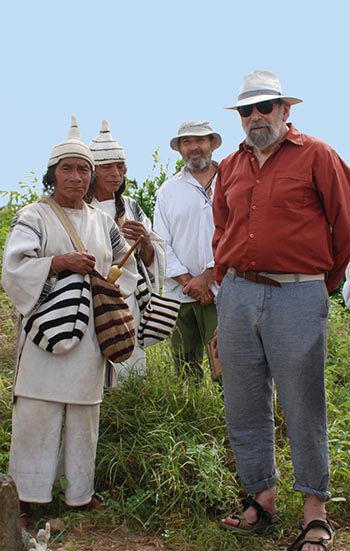Alan Ereira talks about the wisdom of the Kogi Indians and an important new UNESCO project in the Sierra Nevada de Santa Marta in Colombia – From Beshara magazine



In 1991, in the last edition of the original Beshara Magazine, we published an article by journalist Alan Ereira about an extraordinary people living in the Sierra Nevada de Santa Marta in the north of Colombia (to read it click here). The descendants of a great civilisation which fled to the hills as the Spanish took over their lands, the Kogi had lived for 400 years in isolation, led by a class of priests called ’the mamas’. They asked Alan to help them make a film in order to communicate with us – ‘the younger brother’ – and warn us about the ecological destruction we are wreaking upon the earth. The result was a BBC documentary and a book entitled ‘The Heart of the World’. Thirty years later, the Kogi are making another attempt to communicate their wisdom, this time through a regeneration project, Munekan Masha, under the auspices of the UNESCO Bridges initiative. Alan talked to Jane Clark and Richard Gault about what it involves and the unified vision which underlies it. At the end of the article we include a video of a recent talk he gave on the project which you might want to watch before reading the interview.
Video: Kogi Knowledge: Learning Planet Festival, 27 January 2023. Duration: 54 mins

Jane: It is about 30 years since we did an article on the Kogi in the last printed edition of Beshara Magazine and you made your first film about the Kogi for the BBC, From the Heart of the World.[1] So can we begin by doing a little bit of catching up. For instance, since we last spoke you have set up a charitable foundation, the Tairona Heritage Trust [/], which has enabled the Kogi to preserve their culture, and in particular, acquire more land.
Alan: Yes, we established the Trust immediately after making the film. Its job was to allow people to channel their expressions of support for the Kogi in a way that the Kogi would know about. We explored various options, and the most practical was the recovery of ancestral land and sites of importance to the Kogi, along with other things attached to it, such as money for health care and administration. But the great thing about land is that it is permanently there, whereas the rest all disappears into the soil as you spend the money.Over the years, lots of people have helped the Kogi acquire further land, including other NGOs and the Columbian government. So the area of territory has greatly expanded. What is more, the new government, which as far as I know is the first socialist government that Colombia has ever had, has just announced a massive expansion of the Tairona National Park, which gives a degree of protection to lands within the area. This includes the traditional territory of the Kogi and the other peoples of the Sierra. But it only gives a degree of protection; it doesn’t actually transfer any ownership to them, although it limits the things that can be done on the land.
- Message from The Heart Of The World:
‘Don’t Say They Didn’t Tell Us’ – MESSAGE From the Elder Brothers (03/27/2020)
- Voices from the Sacred Mountains
The Arhuaco indigenous peoples of the Sierra Nevada de Santa Marta, Colombia, are known for their century-long track record of environmental protection, but their cultural survival and conservation of this sacred mountain’s ecosystems are at risk. Read more here

